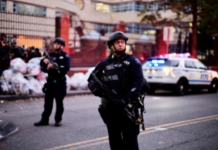News at Northeastern

With the Republican National Convention set to begin on Monday in Cleveland, we spoke with Northeastern professor William Crotty about what actually happens at political conventions and the evolving role these conventions have played in presidential elections.
Crotty, the Thomas P. O’Neill Jr. Chair in Public Life and emeritus professor of political science, was involved in rewriting the convention rules in the late 1960s and early ’70s and is writing a book on the 2016 election, titled Winning the Presidency 2016.
In basic terms, what happens at a political convention?
The conventions are the one national meeting of each political party. Their basic purpose is to choose a presidential nominee and vice presidential nominee. Long ago, these used to be formidable affairs in which the different factions in the party met and fought through the choice of a nominee. Curiously, in both parties there is a continuing division between the moderate or centrist elements in the party and their candidates, and between the more hardcore ideological groups and their candidates.
You mentioned a “continuing division.” How is that playing out in this election?
This year there was a clear division between Hillary Clinton—pragmatic, experienced, sympathetic to Wall Street with a strong record on women and children’s issues—and Bernie Sanders, representing a more liberal element that forced Clinton left on trade policy, workers’ rights, economic inequality, and college costs. Clinton would have been and is comfortable with party leaders and fundraisers. Sanders represented the group more intent on opening the party and empowering participants in the process. Sanders himself is not, nor has he ever been, concerned with party matters. His call for a political revolution fits the attitudinal structure of the reformers.
It is hard to say what exactly Donald Trump represents given his unpredictable campaign, personal attacks on other candidates, and changing positions. Clearly what he has been trying to do is to solidify a more mainstream conservative base in the party and cut off any attempt at a divided convention. His choice of Governor Mike Pence of Indiana is an indication of this. What Trump is not is Ted Cruz and a representative of the “Far Right” evangelical base of the party, although the fact that Cruz has been invited to speak at the convention indicates Trump is not isolating himself from these party members.
Trump has been called a populist and a lot of other things, although how it all plays out beyond a nasty and unusually intensive personal campaign is hard to say. It is a new experience for the country and for the Republican Party and may well indicate a party in transition, one that has bankrupted its Reagan neo-liberal ideology.
How have conventions evolved and what is the primary purpose of today’s conventions?
National conventions used to be the center of the party and political universe. While obviously critical in dictating the future path the country was to follow, that is no longer the case. They were not planned but evolved out of necessity in the 1830s and 1840s. Unfortunately, as the generations passed they became totally corrupted, serving the interests of wealthy industrialists and party bosses.
A direct democracy emphasis on introducing primaries to let the people or at least the party members decide began in the early 20th century. Little changed however. The primaries were used to test the appeal of selected candidates—John F. Kennedy in Wisconsin and West Virginia in 1960—to impress party leaders who still controlled the conventions. The delegates selected were not bound to support the primary winner.
All this changed in something of a revolution coming out of the ’60s and the anti-war fervor and the civil rights movement. Blacks were excluded from national convention delegations in the South, a problem for the national Democratic Party (but not the Republican Party) in the 1964 convention. The resolution after the violent Chicago convention of 1968 was to create a reform commission to open the party to all members and give them a voice in directly selecting the presidential nominee. The answer was to change the rules and make delegates select the nominee.
I was part of the process during the years for 1968 to 1972. It was extremely controversial. The powers within the party—the funders of elections, governors, mayors, members of Congress, and the labor unions—fought the changes and the media attacked them for over a decade. A concession was made in time that allowed party figures and elected officials to attend the convention without having to run in primaries—the Super Delegates that were a point of contention between Clinton and Sanders.
At present, in both parties, the elected delegates in the primaries and caucuses are pledged to vote for the winner for one to three ballots.
Who attends today’s political conventions, and what roles do they play?
The elected delegates attend the conventions, plus approximately 650 Super Delegates. They tend to be party activists who have worked in the campaigns of the candidates they support. Their vote for a nominee is obviously predictable.
They also, however, must put together a platform. This changes some each election depending on the candidate but for the most part there is a strong continuity in both parties over the years on issue positions.
The parties do differ in their agendas and, in fact, are highly polarized in the present and considerably more polarized than they have been in the past. Supporters of the winning nominee have the greatest voice in deciding issue positions. The platforms are not mandatory for the candidates; there is no way to force them to act. Still, and maybe surprisingly, they go a long way in deciding the party positions in the campaign and, once in office, presidents do attempt to enact them.
The convention also decides party rules. These can change each election. For example, after a certain date in March, the Republicans switched from proportional representation of the primary vote to winner-take-all. The intent was to decide on a nominee earlier than, for example, 2012 and avoid the bloodletting that Mitt Romney went through in the southern states. It backfired. A movement against Donald Trump’s potential nomination had begun but given the changes, the advantage went to him.
If there were a credentials challenge to delegates—the 1964 Mississippi Freedom Party’s challenge to the all-white delegation from that state as an example—the credentials committee would decide it.
How involved have this year’s candidates been in forming the platforms of their parties?
In 2016 Clinton is taking a direct role in forming the platform and, as agreed, has made concessions to the Sanders campaign. This makes for a unified party in what could be an election like no other.
Trump, in contrast, has not involved himself in the platform debates, allowing, in particular, the more conservative elements of the party to make their points. Given the race to date, it is unlikely that Trump would feel bound to the pledges.
The 2016 election gives every promise of being an extraordinary election. It is an election year like no other.
(This article is reprinted with permission from News at Northeastern.)














